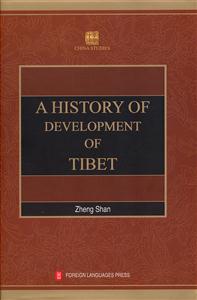-
>
鲍勃·迪伦诗歌集:1961-2012:典藏版
-
>
双城记-英文版
-
>
四级词汇词根+联想记忆法:乱序版
-
>
The secret garden
-
>
哈克贝利.费恩历险记/床头灯英语.2000词读物(英汉对照)
-
>
10000德语分类词汇联想记忆
-
>
英语词汇全书
A HISTORY OF DEVELOPMENT OF TIBET-西藏发展史 版权信息
- ISBN:9787119065380
- 条形码:9787119065380 ; 978-7-119-06538-0
- 装帧:暂无
- 册数:暂无
- 重量:暂无
- 所属分类:>>
A HISTORY OF DEVELOPMENT OF TIBET-西藏发展史 目录
chapter one ancient society of tibet
chapter two the tubo dynasty of the tibetan slave-owning system
chapter three the merging of tibet into china in the yuan dynasty and the establishment of feudal serf system
chapter four the tibetan areas in the ming and early qing dynasties
chapter five tibetan people stand against western powers' invasion
chapter six tibet under semi-colonial status in the period of the republic of china
chapter seven peaceful liberation and birth of new tibet
postscript
appendices
A HISTORY OF DEVELOPMENT OF TIBET-西藏发展史 节选
《西藏发展史(英文版)》内容简介:A History of Development of Tibet is book of great academic value as it traces the course of development of the Tibet Autonomous Region and gives an insight into basic conditions in Tibet today.With seven chapters this book introduces the formation of the natural environment of Tibet the origin of the Tibet ethnic group the multi-ethnic development of Tibet the close relations between Tibet and the Central Plains in Chinese history the powerful influence of the culture of the Central Plains on Tiber's politics economy culture and religion the formation of the various schools of Tibetan Buddhism and the unification of the government and religion in Tibet under the Ming and Qing dynasties and the Republic of China the Tibetan people's heroic struggle against imperialism and feudalism peaceful liberation and democratic reform the realization of ethnic regional autonomy and the building of socialism in Tibet With a wealth of data objective exposition and many new ideas this book will help readers have a good understanding of one of Xhina's most important autonomous regions.
A HISTORY OF DEVELOPMENT OF TIBET-西藏发展史 相关资料
The 1911 Revolution ended the feudal system in China. The government of the Republic of China inherited the Qing's administrative structure in the Tibetan areas. It set up an administrative organ in charge of Mongolian and Tibetan affairs, selected Tibetan delegates to attend the national assembly and appointed its commissioners in charge of Tibetan affairs. Trying to obstruct this, the British government engineered the "Simla Conference" of 1913, seeking to interfere in China's internal affairs and force the so-called Simla Treaty on China, which severely violated China's sovereignty and was an attempt to split China's territory. This British conspiracy was opposed and condemned by all the Chinese people and their government. At the time of the May Fourth MOvement of 1919, the government of the Republic of China (ROC) disclosed to the public the Sino-British negotiation process relating the so-called Tibet problem. It aroused antiimperialist rage among the Chinese people both in China and abroad. Tibetan civil and religious leaders also condemned the British imperialists' attempt to split China at the Simla Conference. The government of the ROC from the very first day of its founding repeatedly declared to Tibet its policy on the republic of the five ethnic groups (Han-Chinese, Manchu, Mongolian, Hui and Tibetan), and at the same time the Tibetan local government time and again told the central government that it was willing to solve any problems left over by history. In 1919 the 13th Dalai Lama indicated to the envoys sent by the government of the ROC his support for the central government and his determination to make joint efforts for the happiness of the five ethnic groups. The Ninth Panchen Lama also actively contacted the central government and appealed for the restoration of normal relations between the central government and Tibet and the maintenance of the unification of the motherland.
- >
我从未如此眷恋人间
我从未如此眷恋人间
¥16.4¥49.8 - >
史学评论
史学评论
¥13.9¥42.0 - >
唐代进士录
唐代进士录
¥19.1¥39.8 - >
李白与唐代文化
李白与唐代文化
¥9.9¥29.8 - >
中国人在乌苏里边疆区:历史与人类学概述
中国人在乌苏里边疆区:历史与人类学概述
¥24.0¥48.0 - >
人文阅读与收藏·良友文学丛书:一天的工作
人文阅读与收藏·良友文学丛书:一天的工作
¥18.3¥45.8 - >
企鹅口袋书系列·伟大的思想20:论自然选择(英汉双语)
企鹅口袋书系列·伟大的思想20:论自然选择(英汉双语)
¥6.3¥14.0 - >
苦雨斋序跋文-周作人自编集
苦雨斋序跋文-周作人自编集
¥6.9¥16.0
-
湖光山色(英文版)
¥15.1¥72 -
诺桑觉寺-中译经典文库-世界文学名著-第五辑
¥3.6¥12 -
无名的裘德-中译经典文库-世界文学名著-第五辑
¥7.2¥24 -
小飞侠彼得·潘(纯英文版)
¥7.5¥19.8 -
莎士比亚戏剧故事
¥5¥12.8
















